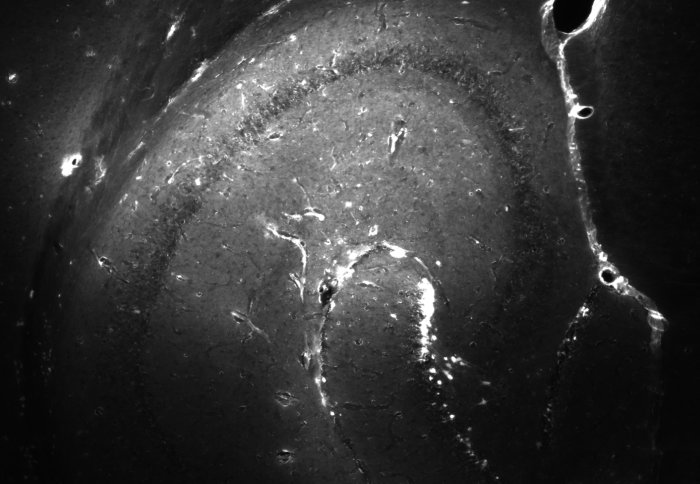New ‘pulsing’ ultrasound technique improves drug delivery to brains of mice

The new technique delivered the drug more evenly throughout the brain
Using rapid short-pulse sequences of ultrasound helps drugs reach the brains of mice, according to new Imperial College London research.
Scientists currently use long-wave pulses of ultrasound to deliver drugs, which can cause side effects.
Now, these new findings from Imperial on shorter-wave pulses could change how drugs are used to help patients of Alzheimer’s and other neurological diseases.
Alzheimer’s, which affects 550,000 people in the UK, can be difficult to treat with drugs due to the blood brain barrier (BBB) - a protective membrane around blood vessels that lets very few molecules pass from the blood stream to the brain. This protects the brain from harmful substances but can also prevent helpful drugs reaching their target.
Our new way of applying the ultrasound could, following further research, literally open up the brain to all sorts of drugs we had previously disregarded. Dr James Choi Department of Bioengineering
One avenue of research involves prying open the BBB to let drugs into the brain. Scientists inject mice with tiny bubbles, or ‘microbubbles’, before applying long-wave pulses of ultrasound radiation to the brain.
The pulses change the pressure in blood vessels, causing the microbubbles to expand and contract. As they do so, they gently pry open the BBB.
However, the long pulses last at least ten milliseconds at a time, which can cause side effects. The longer the BBB stays open, the more chance there is for tissue damage and for harmful molecules to reach the brain.
In a new study published in Radiology, lead author Dr James Choi and colleagues at Imperial compared long-wave ultrasound with shorter-wave, more rapid ultrasound pulses.
They found their new technique was more effective and potentially much safer than current methods.
Dr Choi, from Imperial's Department of Bioengineering, said: “We have found a seemingly effective way of getting potentially effective drugs to where they need to be.”
Prying open barriers
The researchers injected 28 mice with microbubbles, before using short-wave pulses on 14 mice, and long-wave pulses on the other 14.
They found that the short-wave pulses delivered drugs evenly throughout the targeted brain areas without affecting, or damaging, surrounding tissue like the longer waves. The BBB also returned to its usual closed state within ten minutes, minimising potential damage.

Dr Choi explained: “The blood brain barrier is relatively simple to open but current techniques are unable to do so safely - which is why we haven’t been able to use them in humans without side effects.”
The researchers say the new findings could eventually lead to new techniques for getting drugs to human brains in cases like Alzheimer’s, brain cancers, and other disorders involving the brain.
Dr Choi said: “Our new way of applying the ultrasound could, following further research, literally open up the brain to all sorts of drugs we had previously disregarded.
“Many potential drugs that looked promising in laboratory settings never moved on to use in people – possibly because they were blocked by the blood brain barrier when it came to using them in humans."
Dr Sara Imarisio, Head of Research at Alzheimer’s Research UK, who funded the research, said: “With over 550,000 people in the UK living with Alzheimer’s and currently no treatment to slow down or stop the disease, we urgently need to see research to help deliver life-changing drugs.
“While the blood brain barrier protects the brain against damage and infection, it does make it very difficult to deliver treatments into the brain. Although this study exploring how we can penetrate the blood brain barrier was conducted in mice, it’s a critical step before technology like this can be tested in people.
This study was supported by Alzheimer's Research UK, the Biotechnology and Biological Sciences Research Council, and the Wellcome Trust.
“Rapid Short-pulse Ultrasound Delivers Drugs Uniformly across Murine Blood-Brain Barrier with Negligible Disruption” by Sophie Morse et al, published 26 March 2019 in Radiology.
Article supporters
Article text (excluding photos or graphics) © Imperial College London.
Photos and graphics subject to third party copyright used with permission or © Imperial College London.
Reporter
Caroline Brogan
Communications Division